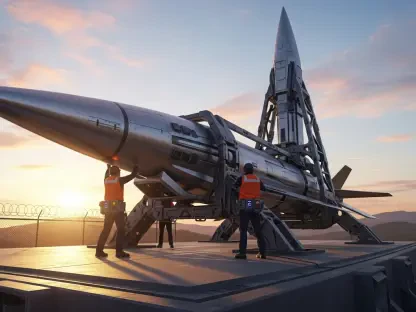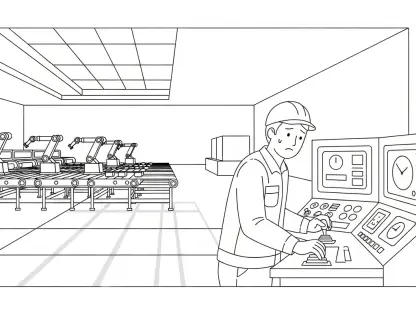The revolutionary potential of 3D-printing technology appears boundless, and its application in space exploration holds significant promise that is beginning to unfold. As NASA propels further into the realm of extraterrestrial science, notably with the Mars Sample Return mission, refining the use of additive manufacturing becomes crucial. This aspect came into sharp focus through the insights of Ryan Watkins, a research engineer at NASA’s Jet Propulsion Laboratory (JPL), when he delved into lattice structures’ roles during his keynote at a recent AMUG Conference. He addressed a formidable engineering challenge: safely returning Mars samples to Earth, highlighting how novel lattice structures can endure high-speed impacts without traditional deceleration techniques like parachutes or rocket thrusters. This promising solution showcases the transformative intersection of additive manufacturing and aerospace engineering, which may redefine future strategies in interplanetary missions and beyond.
Embracing Additive Manufacturing in Space
Additive manufacturing, often termed 3D printing, signifies an industry shift where NASA’s JPL decisively pushes the boundaries. With metal components like titanium and Inconel featuring prominently in the Perseverance rover on Mars, another exploratory feather in NASA’s cap, the organization demonstrates a powerful commitment to integrating 3D-printed innovations. Unlike mere short-lived adoption, these efforts position JPL at the helm of establishing standards, ushering momentum that encourages more inclusive use of such techniques. This evolving exploration envisages a scenario where future missions significantly benefit from this burgeoning technology. The incorporation of metallic 3D printed parts signals not just advancement but steadfast progress in realizing complex tasks in space—a testimony to the prospects that additive manufacturing heralds for both current projects and those waiting in the wings. Production methodologies challenge traditional approaches, facilitating inventions that were confined to the drawing board a few years ago.
Navigating the cosmos necessitates novel solutions and rethinking age-old challenges. Foremost is the concept of destinational landing without employing bulky safety features traditionally required to decelerate objects entering an atmosphere. Here, additive manufacturing takes center stage by presenting a streamlined, innovative approach using crushable lattice structures. These aren’t just theoretical constructs; they offer practical answers to severe engineering obstacles, marking a departure from historical methods. When human ingenuity engineers creative leaps of this magnitude, few speculations on conceptual successes remain off-limits. Insights from experiences with notable missions such as Curiosity and Perseverance accentuate that integrating such advancements already yields tangible successes even before new missions fully initiate.
Lattice Structures: Nature Meets Technology
A notable pursuit within the domain of additive manufacturing is creating lattice structures. Conceptually familiar, these configurations mimic naturally occurring forms found in biological entities, engineered now through advanced design software for man-made applications. Primarily, they serve to reduce weight, improve thermal management, and absorb energy more efficiently—each a vital component echoed in NASA’s ongoing missions. Lattices extend far beyond simplistic forms like foams or honeycombs, welcoming an intricate complexity accessible only because of advanced engineering and printing technologies. Thus, designing suitable lattice structures for specific missions necessitates an understanding of their inherent versatility coupled with applied precision. Here, myriad possibilities emerge, allowing structural designs to be tailored exquisitely for intended uses, ultimately resulting in optimized geometry that synergizes with specific objectives. This metamorphosis of traditional lattice concepts into 21st-century applications strengthens the link between scientific inspiration and practical execution.
In space exploration, lattice structures find particular favor owing to their exceptional energy absorption capabilities. These bespoke designs capitalize on the principle that minimal configuration adjustments can yield significant enhancements. Scientists and engineers balance practical constraints—such as material science limitations and physics-related constraints—creating lattice frameworks that encapsulate and methodize applied kinetic forces. Such ability becomes paramount when speed and protection become synonymous; landers, for example, benefit from knowing they can withstand potentially destructive forces experienced in transit without needing external deceleration mechanisms. The innovation lies not merely in their existence but crucially in finely adjusting complexities to meet specific mission parameters. Recognitions like those advocated by Watkins outline substantial potential for lattices to influence projects from Mars to Jupiter, executing the tasks previously performed by larger, heavier mechanisms.
Innovative Approaches to Lattice Design
The journey into usable and effective lattice structures doesn’t stop at conception; it finds expression through innovative design methodologies and approaches. One substantial hurdle involves achieving optimal placement of lattice structures, considering relational density and scale separation. It’s a multifaceted engineering feat: since lattices are essentially composites of tiny cells comprising a larger structure, they must maintain balance across those dimensions while addressing manufacturing constraints. This duality presents marked difficulties when low-density materials are in play, challenging the removal of internal structure flaws and unwanted defects throughout production. The nature of these dilemmas doesn’t hinge solely on technical proficiency; practical application and logistical execution remain aligned in objective, delivering end results distinct from traditional engineering constraints. Yet, when scientists refine these intricate patterns and smoothen operations near faultlessly, their ingenious methodologies mark definitive progress in a larger strategy connecting Earth-bound engineering marvels with interplanetary mission success tailored to participate exceptionally.
Chemical etching embodies another pioneering endeavor forthwith, offering a practical lens into post-production processes that enhance material properties significantly. Through selective removal of undesired material, this process aligns internal properties more closely with desired mission specifications. Although the technique requires careful detailed development, NASA succeeded in generalizing its application across different materials under controlled conditions. Consequently, by aiding in removing minuscule surface imperfections and internal defects, chemical etching serves as an invaluable post-processing strategy. Inevitably, such technologies won’t readily resolve every potential issue without further iterative testing and execution; their importance lies more broadly illustrating that, solved precariously, these constraints open doors to sustainable progress across myriad future explorations.
Tools Driving Next-Gen Space Solutions
A key facilitator behind NASA’s potentially groundbreaking work includes innovative tools like UnitcellHub, developed to streamline lattice design and evaluation processes. Instead of launching thousands of test runs to determine ideal lattice configurations for each unique circumstance, UnitcellHub operates through software that efficiently bridges these complexities. It doesn’t merely complement engineer insight but propels lattice development cycles forward—efficiently evaluating intricate details without requiring excessive labor-intensive replication. The tool’s three pillars—UnitCellEngine, UnitCellDB, and UnitCellApp—collectively pilot lattice modeling, employing FEA simulations for analyzing multi-variable scenarios. Such advances enable streamlined workflows that provide engineers latitude to make decisions with informed precision. Simulation-based selection drastically reduces unnecessary iterations, retaining only viable lattice candidates that best meet required criteria based upon predicted outcomes. While showcasing this ability, the Mars Sample Return mission becomes far more manageable, preempting potential issues while distinguishing configuration options.
This intuitive platform enabled engineers to prioritize crush durability without exhaustive manual checks, harnessing simulation data to expedite lattice development cycles. By utilizing predictors like yield point analysis to inform crush suitability, UnitcellHub revolutionized component assortment in lieu of extensive physical trials. Each viable design, identified and analyzed through digital simulacrums before real-world testing, highlighted available options ready for active deployment. Watkin’s work thus brings into play technological interventions that safeguard against potential design oversights, bridging established procedural techniques and future implementation needs. Such tools magnificently echo ongoing commitments toward refining traditional space exploration strategies through sophisticated advancements, illuminating new paths into uncharted engineering territory with reinforced assurances based upon precision engineering and compelling proof-of-concept analyses.
Future Potential of 3D-Printing in Aerospace
Despite significant developments already achieved, the progression of lattice technology for mission success presents only steps along a broader trajectory. NASA’s active exploration into pioneering techniques symbolizes extensive steady gains harnessed steadily from continued research and execution. Looking forward implies constantly engaging with yet unexplored alternatives while acknowledging present-day solutions’ validity. Those initiatives foreground a dynamic reflection on the continual evolution traced through celebrated engineering feats over previous missions. Embracing expansive innovation pathways undeniably informs practical direction across aerospace industries, suggesting transformative solutions through interdisciplinary approaches seamlessly integrated into comprehensive exploratory phased initiatives. Coalescing research outcomes with ongoing insights contributes immensely to expanding additive manufacturing applications beyond theoretical interests, significantly influencing day-to-day industry practices across scientific domains worldwide.
These developments also invite contemplation of newer challenges that experts foresee, as space exploration horizons broaden over time. While fundamentals pivot around the presumed adaptability and flexibility inherent within 3D-printed frameworks, NASA and others remain ever determined to push the boundaries of non-traditional manufacturing methodologies. Delivering sustainable self-reliant solutions may mark the dawn of a new epoch in lunar and intergalactic exploration, attributed largely to increasingly sophisticated digital and material technology revolutions. Progress requires an acknowledgment that additive manufacturing transformation transcends hypothetical scenarios, informing mission architecture in essential ways, even as scientists and engineers systematically innovate. Hence, drawing adaptively from history reflects well-established design principles culminating in new challenges as interdisciplinary progressions take shape. Indeed, merging these factors reorients aerospace paradigms advancing additive manufacturing into future factored-in considerations for integral mission architecture, aligning with expansive conceptual developments.
Redefining Mission Architectures with Additive Manufacturing
Additive manufacturing, commonly known as 3D printing, signifies a transformative shift, with NASA’s JPL boldly expanding its boundaries. Utilizing metal components like titanium and Inconel, prominently seen in the Perseverance rover on Mars, NASA further showcases its commitment to integrating 3D-printed innovations. These efforts transcend simply a temporary adoption phase, positioning JPL as a leader in setting industry standards and promoting widespread use of these techniques. This forward-looking exploration envisions a future where missions significantly gain from this advancing technology. The inclusion of metallic 3D printed parts not only highlights technological progress but marks a significant stride in undertaking complex space tasks, emphasizing the promising prospects additive manufacturing brings for both current endeavors and upcoming projects. Production methodologies challenge conventional approaches, enabling creations that were restricted to the drawing board merely years ago. Innovative crushable lattice structures offer practical solutions to longstanding engineering challenges, illustrating a redefinition of traditional landing techniques.









